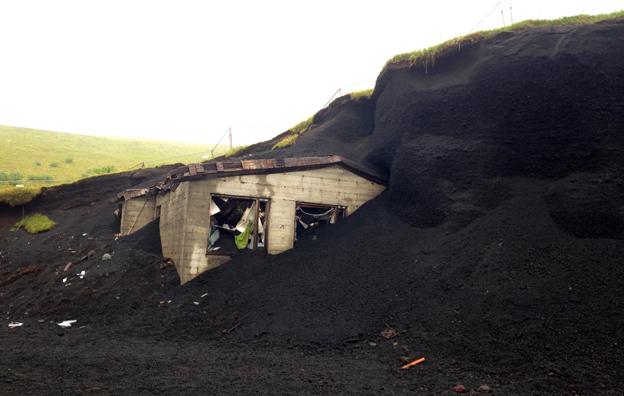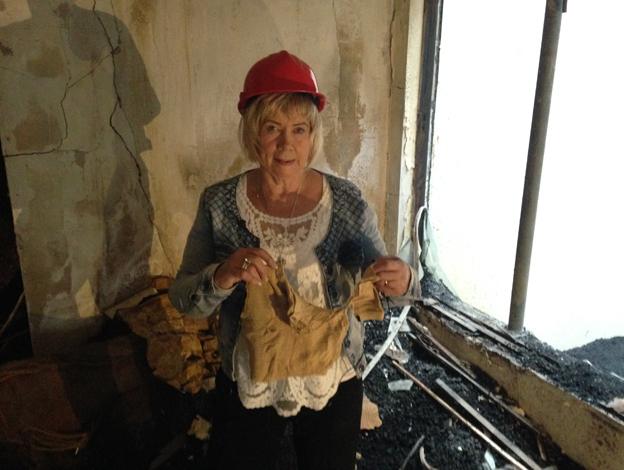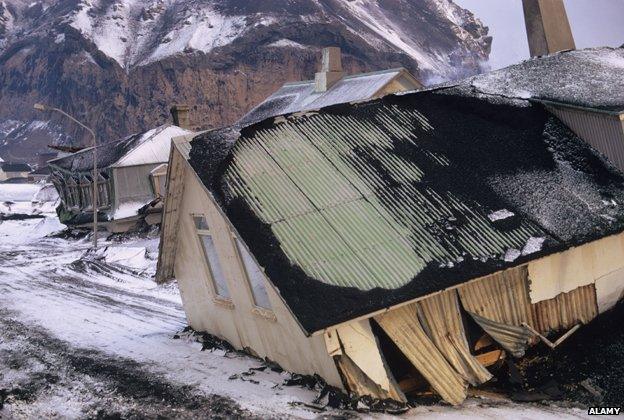Iceland's 'Pompeii' emerging from the ash
- Published

A lava eruption near Iceland's Bardarbunga volcano has raised the spectre of flights being grounded by a plume of ash. But 41 years ago, an Icelandic eruption did much more than that, burying hundreds of houses. Today, the "Pompeii of the North" has become a tourist attraction.
"Wake up, something terrible has happened on the island! There is an eruption!" Helga Jonsdottir's mother shouted as she shook her awake at 02:00 on 23 January 1973. She was 17, and lived on the Icelandic island of Heimaey. In the early hours of that morning a volcanic system that hadn't erupted for 5,000 years burst open without warning, ripping a 2km (1.2 mile) tear through the earth.
Now Helga runs a memorial cafe on the island, commemorating that night. Each table top is covered with the photos and stories of the families whose homes went under the lava. She sits over a steaming coffee and tells me her story.
"I ran to the window in front of my bedroom and could see a column of fire reaching from the earth to the sky. I was terrified," she says.
Helga's family fled the house and headed to the harbour to escape by boat. As they left the port they saw to their horror that a tongue of glowing lava was snaking along the ocean floor heading in their direction. "At that moment we thought, this was maybe it - these were our last moments," Helga tells me.
Incredibly, almost all the island's 5,000 inhabitants managed to escape. There was only one death, caused by a gas explosion. But the eruption lasted for five months, smothering 400 of Heimaey's houses. Those who evacuated had to set up life on the mainland as refugees. Many of those I speak to tell me it was a very painful time. Helga moved house a dozen times in one year. She, like many others, was determined to return.

Now it's hoped the events of that night can be used to bring tourists to the island. Archaeologists have been uncovering what's left of the buildings, giving the island the nickname, "Pompeii of the North". An entire museum has been built around the remains of one of the homes.
Gerdur Siguroardottir lived there with her three small children. The youngest was still a newborn baby. She guides me through the heaps of black ash that still cover much of the house and shows me the remains of her living room. I can make out the shape of the sofa, but like much of the house it disintegrated and melted in the intense heat.
Some rooms have been partially preserved by the 15m (49ft) of ash and solidified lava that covered the house. Gerdur has pulled out some of the belongings that remain intact. She reaches down and shakes charred dust from a piece of material, and tells me "from my newborn" - she had been knitting this tiny jumper in the hours before the eruption - and was forced to leave it behind.

Others on the island weren't as happy to uncover the remnants of a traumatic past. In the digging process, part of the neighbouring house was also unearthed. Its roof and top windows poke out from beneath the mountain of ash that sits behind the museum. A lady who is visiting with her young son comes over and tells me that her parents used to live there. For them it's too painful to see the buckled shell of their house after 40 years. She gestures to the sunken home and tells me, "It was a chapter they have already closed."
But Gerdur has come to terms with seeing her belongings again, decades after she left them. She stands proudly in front of her house as tourists take pictures, delighted that people can learn about the island's history by looking through the remains of her home. She points to the roof of the building, which withstood the impact of the eruption and says, "My husband said 'I'm only going to build a house once in my life, and I'm going to use the best quality materials." He was building a strong house to be here forever. And in a way he was right."

Watch Joanne Whalley's video report from Heimaey on the Travel Show website
How to listen to From Our Own Correspondent:
BBC Radio 4: Saturdays at 11:30
Listen online or download the podcast.
BBC World Service: Short editions Monday-Friday - see World Service programme schedule.
Subscribe to the BBC News Magazine's email newsletter to get articles sent to your inbox.